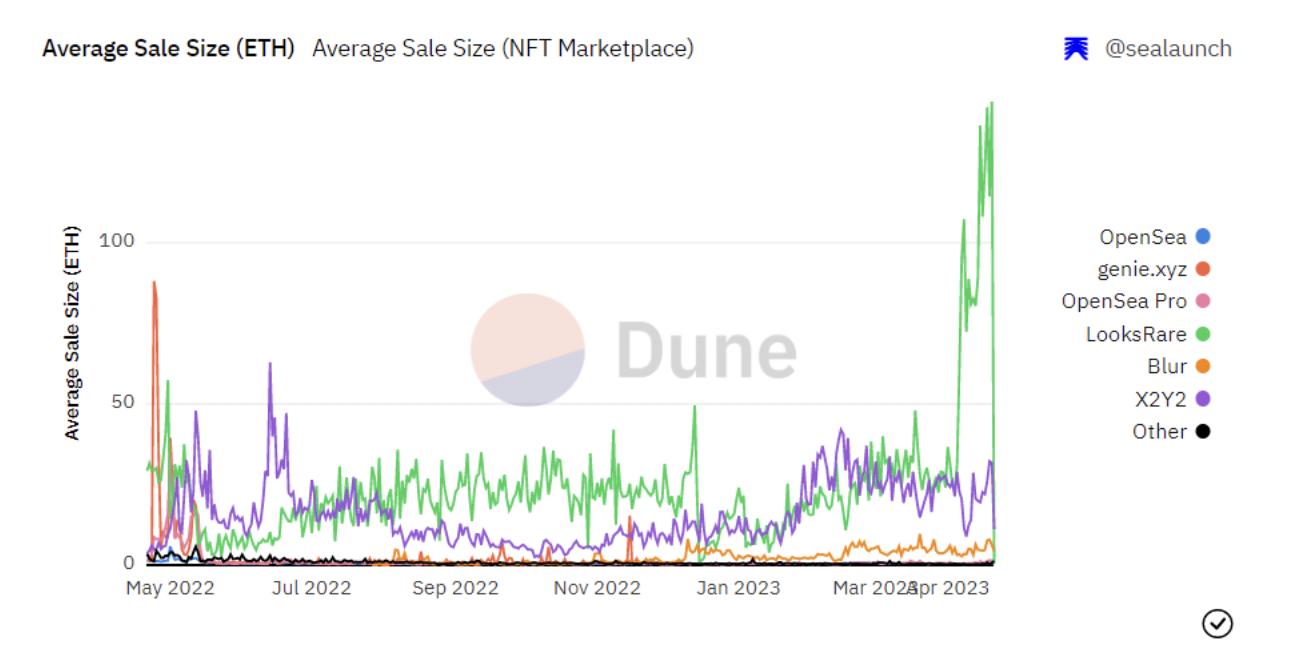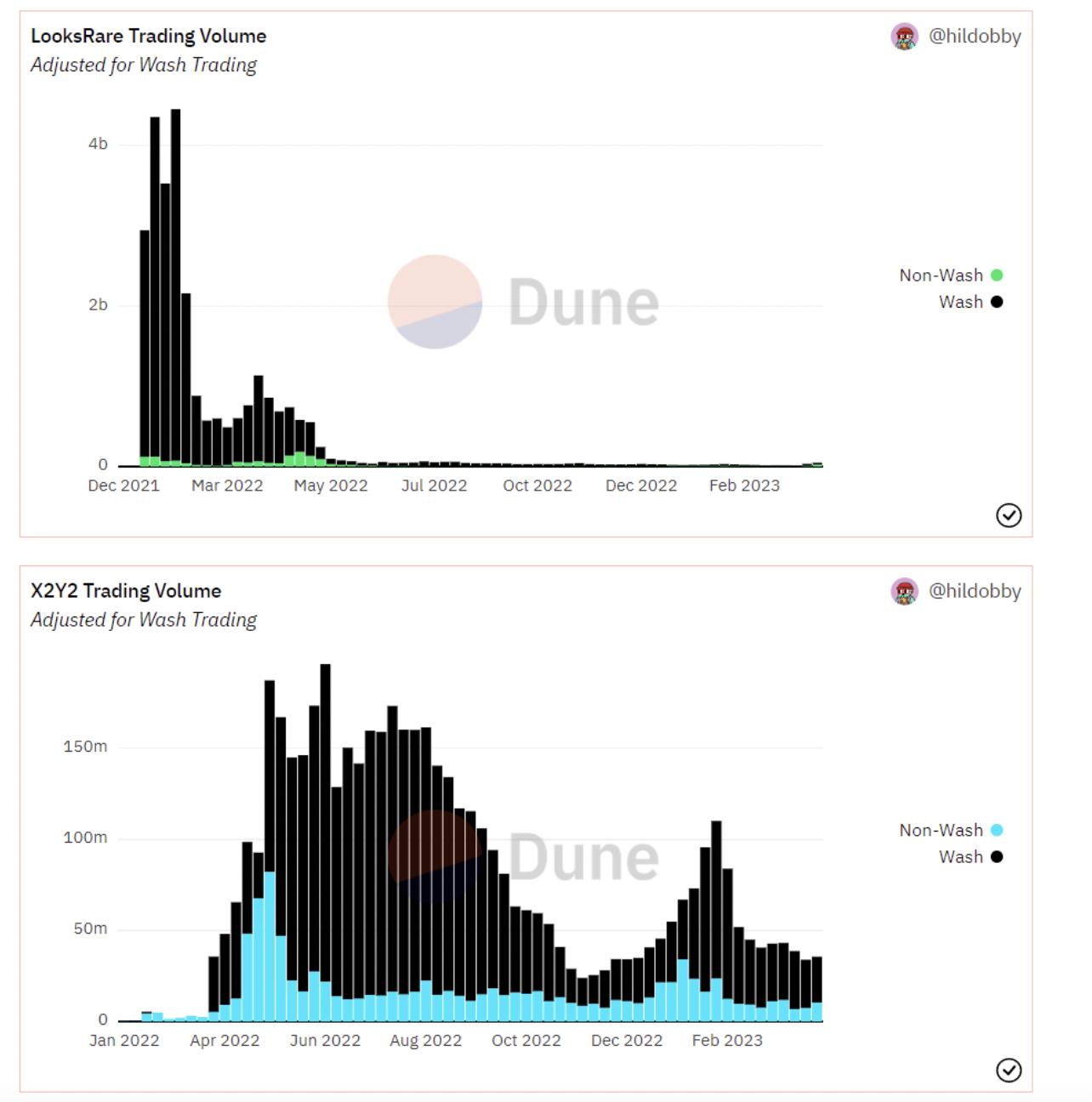Research on the Survival Status of NFT Trading Platforms (2): The Dead End of Trading Mining
Author: nobody (Twitter: @defioasis), Wu Shuo
Related Reading: “Research on the Survival Status of NFT Trading Platforms (1): The Competition Among Leaders in the Post-Royalty War Era”
This article is the second part of the research on the survival status of NFT trading platforms, exploring the dilemmas and breakthroughs of trading mining platforms LooksRare and X2Y2, whether to lie flat or to push through.
LooksRare and X2Y2 are representatives of the trading mining model, being among the earliest practitioners and continuing to this day. A notable characteristic of trading mining platforms is the extremely high unit price of each transaction. In a bear market, this characteristic is profoundly reflected in the very few users, yet it supports a massive trading volume on the platform. Data from @SeaLaunch_ shows that during a period in April, the average transaction amount on LooksRare could exceed 100 ETH, and even under normal circumstances, the average transaction amount for LooksRare and X2Y2 is between 20-30 ETH, which is almost 40-60 times that of OpenSea.

Data Source: Dune
The core logic of trading mining is not complicated; 100% of the platform fees paid for each transaction are captured by Token stakers. Generally, the team/foundation or treasury will retain a portion of the Token for staking to share the captured platform fees, serving as development funds for the protocol. Theoretically, the larger the trading volume created by the platform, the more Tokens users stake, the larger the absorbed platform fees, and the more fee rewards captured.
Therefore, trading mining can easily form a positive drive in the early stages of development from 0 to 1, acquiring airdrops for trading, with increased trading volume leading to increased platform fees, which are captured by stakers, resulting in increased staking yield APY, rising Token prices, and an increase in the potential reward value of trading mining, attracting more users to engage in trading mining. However, with the downturn in the broader environment, the emergence of competitors, changes in market share, and Token halving, this trading mining model can easily lead to a negative spiral for the Token.
The wash-trading in trading mining is not as complex as that of Blur; it mostly involves large holders trading back and forth among a few wallets they control. As long as the subsidized Tokens can cover the pre-paid platform fees, it is profitable. Moreover, the subsidies are settled daily, and after receiving the Tokens, there is almost no loyalty; users sell immediately to recover their costs and then decide whether to continue selling profits or to stake and reinvest.
Data from @hildobby_ shows that in the trading volume for the week of April 10-16, LooksRare had a cumulative trading volume of $47,903,449, with wash-trading accounting for 45.6%; X2Y2 had a cumulative trading volume of $36,039,982, with wash-trading accounting for 69.6%. This wash-trading-based trading mining activity has brought continuous selling pressure on the platform Tokens amid the sluggish demand of the bear market, and LOOKS and X2Y2 have performed poorly for a long time, especially for X2Y2, which lacks market makers.

Data Source: https://dune.com/hildobby/nfts-wash-trading
The prolonged decline in Token prices without support has brought a lot of negative sentiment and FUD to the community, particularly evident in communities primarily composed of Chinese users. However, even with the decline, unless the project team reshapes the tokenomics, it is unlikely to immediately abandon this trading mining model in the short term, as the project's revenue source almost entirely relies on the fees captured from the retained staked Tokens. Therefore, if the utility of the Token is not reshaped in the tokenomics, blindly canceling trading mining would undoubtedly cut off their revenue source.
However, as more of the produced Tokens flow into the market, the difficulty of modifying the tokenomics increases. Token Unlock data shows that currently, LOOKS has circulated 81.35%, and is expected to be fully produced by March 1, 2024; X2Y2 has circulated 72.17%, and is expected to be fully produced by April 3, 2024. With less than a year remaining for production, meaning there are less than a year of mining incentives left, and with the continuous reduction of rewards, the two main exchanges focusing on trading mining urgently need to find new survival opportunities and development directions to regain market share.
In the face of internal and external challenges, the two may be heading down different paths. X2Y2 is rethinking its market positioning, shifting from a single spot trading platform to a comprehensive financial ecosystem based on NFTs. X2Y2 Loan is the first step and an important layout in NFTFI. Currently, X2Y2 Loan holds about 10%-15% of the market share in the NFT lending sector. The second step is to expand alliances, broadening the ecological functionality around X2Y2.
Dew, a trading aggregator for NFT traders based on Polygon, is the first partner, and more partners representing specific segments of the NFT market are expected to join in the future. There may also be plans to introduce NFT futures contract trading. However, the lack of communication with community users may lead to misunderstandings about the strategic shifts, resulting in significant community FUD, which is something the X2Y2 team urgently needs to address.

Data Source: https://dune.com/yaloong/x2y2-loan
LooksRare, on the other hand, remains more focused on the platform itself, and its current situation is relatively better than that of X2Y2, thus it is somewhat more laid-back. This is primarily due to LooksRare's long-term good maintenance of the DeFi OG user group, as evidenced by BitMex CEO Arthur Hayes often mentioning it in his blog posts. Additionally, in my view, during the royalty war, LooksRare has remained relatively low-key, preserving its strength and not losing too much user goodwill. A profound example is when Blur announced its airdrop and formally declared war on OpenSea, X2Y2's untimely intervention made it a subject of ridicule.
This was originally a direct confrontation between Blur and OpenSea, allowing users to choose one, without direct collision with other platforms. However, at this moment, X2Y2 suddenly intervened, saying, "They can choose neither; choose me." Blur dared to challenge at this time because most core data points were close to or even exceeded OpenSea, and the core users had become inseparable to some extent, thus possessing the strength to challenge. At that time, trading mining had already declined, and various data were far behind.
To put it bluntly, at that time, X2Y2 was not on the same level as Blur and OpenSea. The lack of clarity in market positioning and blind intervention brought negative effects instead. LooksRare did better in "watching the show" and making choices; not participating in the final showdown between Blur and OpenSea was undoubtedly the right decision. Later, LooksRare and Blur jointly announced that by default, they would not display third-party platform tags (including OpenSea blacklist tags) in the UI, which garnered goodwill from many users. Now, LooksRare has also developed an app similar to OpenSea and is in internal testing for a trading aggregator similar to Blur.










